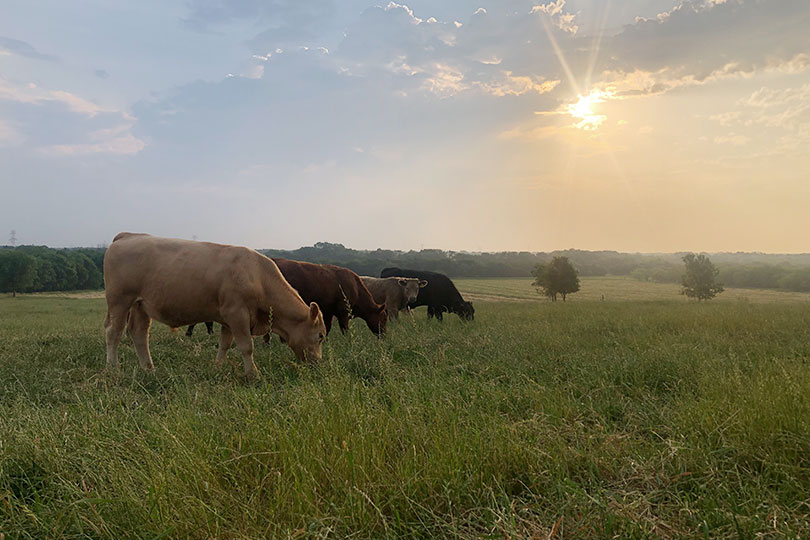By Jennifer Dorsett
Field Editor
The COVID-19 pandemic has had an unprecedented effect on Texas agriculture. Since social distancing and shelter-in-place orders were implemented, consumer purchasing habits shifted to meals at home, creating disruptions in food and agricultural supply chains across the nation as manufacturers, suppliers and other industry pieces struggle to adapt.
In Texas, where agriculture is a major economic driver, the total impact is still being tallied, but a preliminary report by Texas A&M AgriLife Extension Service’s Agricultural & Food Policy Center shows a devastating blow to Texas farmers and ranchers.
“The public needed to understand how bad the impact has been on production agriculture,” Dr. Joe Outlaw, Texas A&M AgriLife Extension Service agricultural economist and co-director of the Agricultural & Food Policy Center, said. “We don’t want people to misunderstand or underestimate the scope of how deep these problems run.”
The report shows prices on agricultural commodities have dropped 20-30 percent, estimating Texas farmers and ranchers may lose $6-$8 billion without intervention or price recovery.
So far, ranchers, dairy farmers and farmers who grow grains, fruits and vegetables are feeling the impacts and uncertainty caused by COVID-19, according to Outlaw.
“Everybody understands about cow-calf producers, stockers and feeders because the cattle and beef markets have really been in the spotlight lately, but other commodities like ethanol and corn, those have really been affected, as well,” Outlaw said. “The drop in demand was just unprecedented, and it’s been a big concern for corn farmers.”
Row crops
Corn, cotton, wheat, sorghum, rice and soybean farmers are all hanging onto their seats as they enter the 2020 crop year, Outlaw said.
Farmers are starting the year with crop insurance prices that are lower than the past two years, he explained, so farmers are facing the loss of 20 to 30 percent of a crop before seeing any insurance benefits.
“The only losses row crop farmers would currently be incurring are from the sale of 2019 crops from storage,” Outlaw said. “And while Texas producers typically do not store commodities this far into the marketing year, many continue to work through carryover stocks from the 2019 crop year.”
Risk management strategies, crop insurance and farm bill programs will all help with depressed prices, Outlaw noted. But without additional aid, financial stress will grow.
“We’ve had so many people calling to tell us that this is actually bigger than anything they’ve ever experienced,” he said. “In the ’80s, when farmers went through some similar economic problems, they weren’t spending as much on inputs as they are now, so it’s definitely a very scary and challenging time.”
Livestock and dairy
The report shows livestock and dairy losses have been the largest due to the shift in demand from food consumed away from home, such as in restaurants and foodservice settings, to food consumed at home.
Production lines and processing plants set up to produce bulk packages cannot be easily modified to shift to smaller packages for retail settings, so markets dried up for some products almost overnight.
Temporary closures and labor shortages at meat packing plants due to COVID-19 outbreaks have also slowed and reduced production.
“While a lot of losses have yet to materialize, for those producers marketing now—including dairy products, which are marketed daily—the pain is immediate,” Outlaw said.
Specialty crops
As with livestock, losses in specialty crops, such as fruits and vegetables, are related to demand shifts.
“The specialty crop sector has been one of the hardest-hit sectors of agriculture due to the COVID-19 pandemic,” Outlaw said. “Most fruits and vegetables are consumed fresh and are highly perishable. As a result of the COVID-19 pandemic, the closure of most restaurants and schools has caused a major reduction in demand.”
If COVID-19 issues persist, Texas fruit and vegetable farmers could be left without outlets for their highly perishable products and could lose over $397 million, the report stated.
Financial assistance
Federal assistance has been made available, but more is needed, Outlaw noted.
In mid-April, President Donald Trump and U.S. Secretary of Agriculture Sonny Perdue announced the Coronavirus Food Assistance Program (CFAP), which provides $16 billion in direct support U.S. farmers and ranchers and $3 billion in commodity purchases and distribution.
But while the federal government’s support is appreciated, more will be needed for farmers and ranchers to remain in business, according to farm groups.
“The disaster package that recently passed, CFAP, isn’t much bigger in total than what we expect losses in Texas alone to be like, and it’s supposed to be for the whole country,” Outlaw said. “I don’t want to cry wolf, but if prices aren’t up by harvest, agriculture is going to be a wreck.”
Click here for details on CFAP for farmers and ranchers.
Outlaw also noted additional reports will be released from the Agricultural & Food Policy Center.
“This report was just our first dive into what’s happening in agricultural markets,” he said. “We’ll be producing more reports to continue outlining the pandemic’s effect on Texas farmers and ranchers.”

